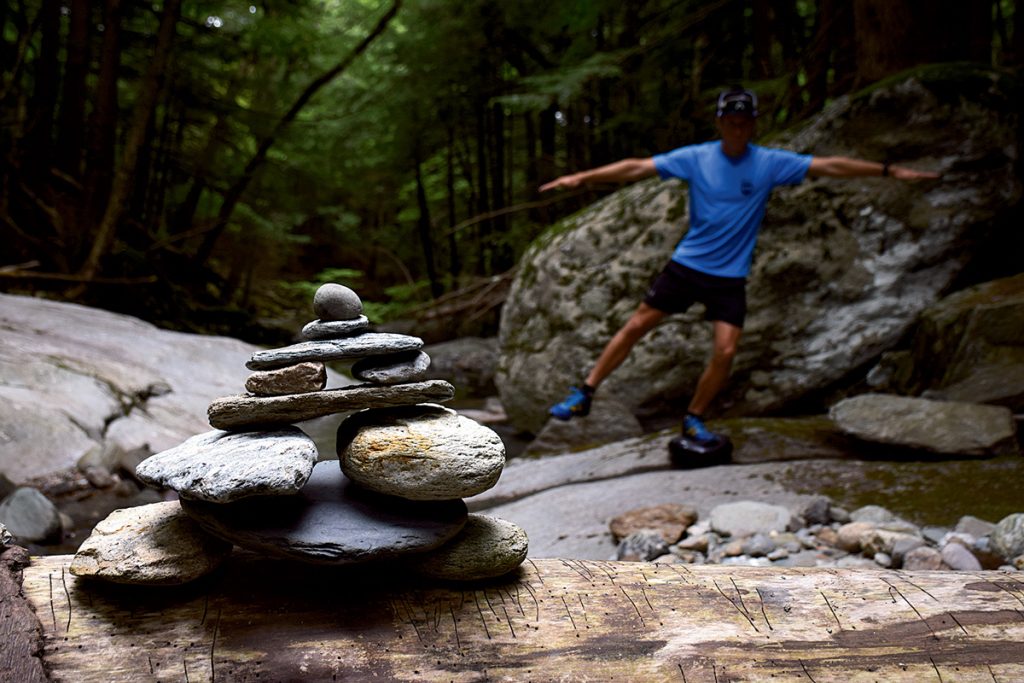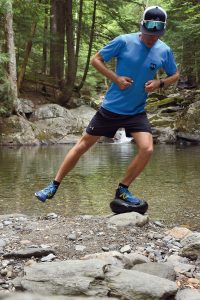A sharp, twisting downhill; the wind watering your eyes; icy patches on the trail; rocket ships on your feet; flat light; and snow falling furiously—how do you keep your balance in such a tough situation?
Nordic skiing is full of tricky tasks as it is—moving over a slippery surface with constant terrain changes is enough to challenge your balance in even the best conditions. But there are ways to improve balance progressively, with simple tools that are easy to acquire and exercises that are easy to repeat. By adding complexity to these balance exercises, it’s possible to constantly up the challenge and find new ways to improve.

Three great tools include a balance board, balance disc and Bosu Ball. Each are shaped differently but share a common trait of getting your feet off the ground and making your body unstable. They can be used independently or interchangeably to improve balance even with just a few minutes each day.
Balance Board
The standard balance board is one of the simplest tools for improving balance: whether purchased or simply crafted from a can of soup and a 2×4, it’s a no-frills piece of equipment that positions a lever atop a centered fulcrum. Keeping your balance tuned requires that both feet stay off the ground—picture a teeter-totter with two playmates of identical weight suspending themselves in the air. As long as you remain focused on engaging the small muscles in your lower and upper body that regulate balance, your feet will stay afloat.
Slide a foot to one side, and you’ll find yourself countering by extending your hips and torso in the opposite direction. Sliding each foot outward and back is a good way to practice the balance required by shifting from ski to ski in the skate technique.
Add complexity to challenge balance. On the board, up the stakes by holding something like a medicine ball or ski pole out front of you. Increase the difficulty by putting that object in motion and trying to retain your balance and keep both feet afloat. Move a medicine ball up and down or around your back and to the front again. Tap a ski pole to one side of the floor and then another. Every movement adds challenge as you react to the different forces working against you.

Balance Disc
A balance disc is a small, portable and versatile piece of inflatable rubber that’s roughly the size of a large dinner plate. Balance discs are often used for physical therapy and injury rehabilitation for ankles and hips.
Unlike a balance board, a balance disc has the ability to more directly mimic Nordic skiing’s body positioning by isolating one foot at a time—because unless they are double poling, a Nordic skier is rarely on both feet at once.
For some, standing on one foot on the disc will provide enough challenge to get started. But pay particular attention to how you are standing on that foot: Your knee and ankle should be flexed in a supple position that allows your body and muscles to react to small changes in position and remain balanced.
Just like with a balance board, the first additional challenge with a balance disc is to add an element to the upper body. Hold a tennis ball or an apple in one hand or hold a heavier object in both hands. Increase the difficulty by moving the object in space: Move it up, down and around or try bouncing it off the wall or floor and catching it. It may start to feel like you’re in a PT studio, but really you’re just improving your all-around balance and coordination—no prior injury required.
Bosu Ball
A unique tool that combines elements from both the balance board and balance disc, the Bosu Ball is a bit more niche and not as easy to craft at home. That said, it can be worth the investment given the variety of exercises for which it can be used. This tool is essentially a large, squishy dome with a flat bottom: Picture a physio ball cut in half.
When used dome-side-up, the Bosu Ball is like a large balance disc—it’s a bit easier to balance on, given the stable bottom platform. This flat bottom also allows for more dynamic movement. A great exercise to do with the Bosu Ball involves jumping from the floor and landing one-footed on the ball. Swing your arms, drive your knees and mimic a classic skiing stride. Landing on a round, wobbling disc is much harder than having tracks to guide your skis, so this exercise can be particularly helpful for everyday classic skiing.
With the flat side of the disc facing up, you have a wobbling platform that is wide enough to stand on. Consider it a balance board that moves in all directions instead of just side-to-side. The ample space means you can involve lower body work alongside balance practice. Challenge yourself to do squats on the Bosu Ball or take a page from the Midwinter issue of Cross Country Skier (2020, #39.2) and utilize bands for hip strengthening and balance at the same time.
Your balance on skis can improve greatly with these tools, but there are plenty of benefits to having better balance in general. You might find yourself more stable while running, stronger in your core and less prone to injury. Standing around on squishy discs is not the most glorious training, but never overlook how much the small details can affect the entire skiing experience.
This story first appeared in the Autumn 2020 issue of Cross Country Skier (#40.1).